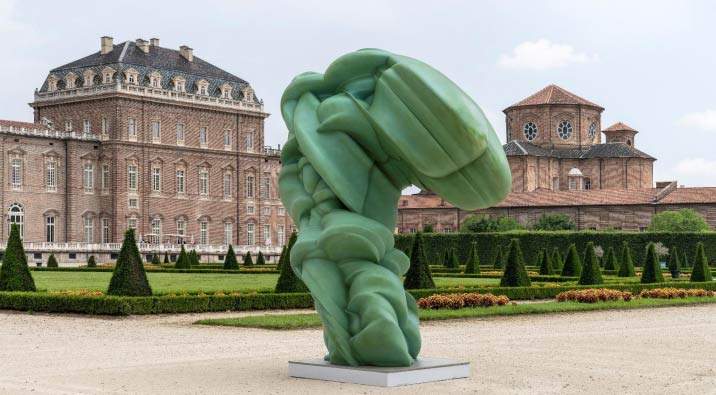Tony Cragg's works arrive at Venaria Reale. Ten monumental sculptures
The works of Tony Cragg (Liverpool, 1949) arrive at Venaria Reale: for the British artist, it is a return to Turin, where three very tall bronze sculptures with the unusual shapes of sinuously twisting columns, with elliptical spirals rising toward the sky in a balance that seems precarious, stand out in Corso Sebastopoli, right in front of the entrance to the Olympic Stadium, the former Municipal Stadium, so renamed during the 2006 Turin Winter Olympics. For that occasion, the triple installation, titled Points of View, had been created on commission by the De Fornaris Foundation to symbolize the Olympic event by Tony Cragg, one of the world’s most successful contemporary British artists, born in Liverpool in 1949 and living in Germany since 1977 in Wuppertal, where he has created a large sculpture park in which exhibitions and works by many famous contemporary artists can be seen.
Now, Tony Cragg is returning invited by Guido Curto, director general of the Consortium of the Royal Residences of Savoy, to create an exhibition at the Reggia di Venaria from June 9, 2022 to January 8, 2023 that will present a selection of ten sculptures created between 1997 and 2021, setting them within the permanent exhibition itinerary of the Reggia, beginning in the Court of Honor, continuing in the High Park of the Gardens of the Reggia, and ending in the atrium of the Scuderie Juvarriane. These are large-scale works, shaped using a variety of materials (from bronze to wood, fiberglass to steel), all connoted by the typical wavy and sinuous lines, which seem to be modeled on a giant potter’s wheel, reconnect with the genius loci of the Reggia in a kind of postmodern redefinition of the Baroque and Rococo styles.
Tony Cragg’s work analyzes the multiple relationships that exist between human beings and the environment. Making use of a wide selection of materials and sculptural techniques, the artist thematizes the complex connection between figure, object and landscape, which for Cragg includes geological and microbiological systems as well as urban and industrial contexts. The focus of Tony Cragg’s artistic work is also centered on a relentless process of exploring the possibilities of material and reshaping the world around us. The artist states, “there are many more things that do not exist than there are,” referring to a source of situations that are still beyond our perception. For Cragg, sculpture is a method of opening this enormous potential to new forms and meanings, to dreams and the languages associated with them.
Tony Cragg (Liverpool, UK, 1949) has lived and worked in Wuppertal, Germany, since 1977, where since 2008 he has started the Skulpturenpark Waldfrieden, a foundation that bears his name. Recent solo exhibitions include: HEART-Herning Museum of Contemporary Art, Herning, Denmark, 2022; Haus am Waldsee, Berlin, Germany, 2021; Houghton Hall, Norfolk, UK, 2021; Boboli Gardens, Florence, Italy, 2019; Yorkshire Sculpture Park, UK (2017); Havana National Museum, Cuba (2017); MUDAM Luxembourg, Luxembourg (2017); Ludwig Museum, Koblenz, Germany (2017); Wroclaw Contemporary Art Museum, Wroclaw, Poland (2017); Hermitage, St. Petersburg, Russia (2016); Von der Heydt Museum, Wuppertal, Germany (2016); Benaki Museum, Athens, Greece (2015); Gothenburg International Sculpture Exhibition, Gothenburg, Sweden (2015). In 1988 he represented Britain at the 43rd Venice Biennale and in the same year was awarded the Turner Prize by the Tate Gallery, London, UK. Elected Royal Academician by the Royal Academy of Arts in 1994, he received the Praemium Imperiale for Sculpture from the Japan Art Association in 2007. He was appointed CBE in 2002 and Knight’s Bachelor in 2016.
Also presented in parallel with Tony Cragg’s exhibition is Dove le stelle si avvicano di una spanna più by another great contemporary master already at Venaria, Giovanni Anselmo (Borgofranco d’Ivera, 1934). Although this sculpture has been on permanent display in the center of the Grand Parterre of the Gardens for several years, to date it had never had an official presentation. This work of his, consisting of six gigantic slabs of black granite, with the inscription that gives rise to its title scanned and engraved in depth on it, refers to a kind of bradyseism approximately as high as the size of an open hand; the work, on which one can climb, allows the stars, which night and day come closer on its vertical, to come one span closer. With this new exhibition, that dialogue between the Residenza di Venaria and contemporary art that was started by the first director of the Reggia, Alberto Vanelli, is resumed and strengthened with Giuseppe Penone’s Giardino delle Sculture Fluide: the founding nucleus of the contemporary Reggia project.
Photo by Pino Dell’Aquila
 |
| Tony Cragg's works arrive at Venaria Reale. Ten monumental sculptures |
Warning: the translation into English of the original Italian article was created using automatic tools. We undertake to review all articles, but we do not guarantee the total absence of inaccuracies in the translation due to the program. You can find the original by clicking on the ITA button. If you find any mistake,please contact us.




























